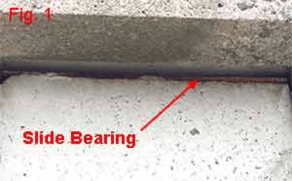Initial installation of a Slide Bearing Assemlbly can be very different from the eventual replacement of the very same bearing. Virtually, all bearing assemblies are intended to be replaced at some point during the life of the structure. This is true of Teflon® Slide Bearings and the more durable Fluorogold® Slide Bearings. It also holds true for Elastomeric Bearings, Viblon Shims and Bearings and Commercial Grade Neoprene. In our experience, we have not seen an application where a bearing assembly was intended to be permanent.
 In new construction, the erector has several advantages. Most importantly, clear access to the surfaces and members the slide bearing will interact with. Once the structure is complete access can be much more restricted. Fig. 1 shows a slide bearing assembly resting on top of a concrete pier which supports the concrete beams above. It is difficult to see in the photo, but the upper beam has a recessed cavity the Teflon® Slide Bearing sits in. The upper beam will need to be jacked up and properly supported during the replacement. So, this recess will require the beam be lifted further to allow the clearance required.
In new construction, the erector has several advantages. Most importantly, clear access to the surfaces and members the slide bearing will interact with. Once the structure is complete access can be much more restricted. Fig. 1 shows a slide bearing assembly resting on top of a concrete pier which supports the concrete beams above. It is difficult to see in the photo, but the upper beam has a recessed cavity the Teflon® Slide Bearing sits in. The upper beam will need to be jacked up and properly supported during the replacement. So, this recess will require the beam be lifted further to allow the clearance required.
The real issue in repalcement is how the upper and lower slide bearing plates are secured to the steel weldment plates. (Not visible) Remember each surface has 3/32” Fluorogold® or Teflon® bonded to either 1/8” or 1/4” thick carbon steel backing plates. It is these backing plates that will be tack welded to the weldment plates. If the original installer anticipated the replacement process, there will be four tack welds, each on the upper and lower plates.
To review Slide Bearing Installation and Welding click here.
In a situation like the one shown in Fig. 1, four opposing tack welds would suffice. Further, they should be on the sides of the Slide Bearing, most easily reached when the bearing needs to be replaced. The welds on the side of the beam will afford easier access than the ones that would be on the long side shown in red. (See Fig. 2)
The life span of the bearing should also be considered when designing the connection. If we focus only on Teflon® Slide Bearings, consider the difference in longevity of these two situations:
- Slide Bearing Assemblies at the roofline of a large flat roof structure. These are usually mounted under the joist flanges and sit on top of embedded steel plates. Covered by the roof, the facia and sheathing these bearings have no direct exposure to the elements.
- Slide Bearing Assemblies on a pipeline. These bearings are exposed to just about every enviromental condition possible. Pipelines often run through desolate arid terrain, therefore the most debilitating effect on the bearings will be from sand, dust or grit that finds its way onto the Teflon® or Fluorogold® surface. Once embedded on the surface, it will act as an abraisve and accelerate the decay of the bearing. Typically, every support will have a bearing system. As an example, a pipe with a 24” inside diameter requires support to be 32 feet apart to eliminate noticeable deflection. Even at 64 feet between support, this implies 82 supports per mile. So, ease of replacement now becomes a major factor.
The difference in maintenance costs between examples A and B is dramatic. In example A, the bearings can last 20 to 30 years. This is approximately the lifespan of the roof itself so the Slide Bearing maintenance and the roof replacement can be incorporated into one job and minimize the cost of both. On the other hand, in example B, the Pipeline, the Slide Bearings will require more frequent maintenance intervals. As well, they will most likely be the only part being replaced. Therefore, when designing and installing the Pipeline Slide Bearings, it is very important to consider the frequency and ease of replacement.





